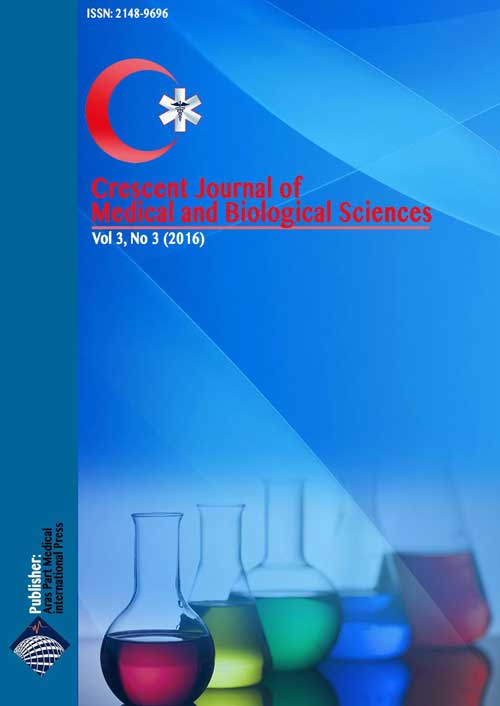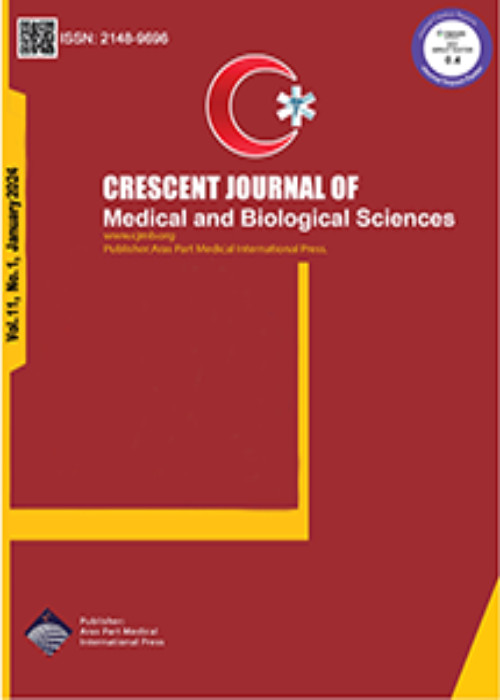فهرست مطالب

Crescent Journal of Medical and Biological Sciences
Volume:3 Issue: 3, Jul 2016
- تاریخ انتشار: 1395/05/04
- تعداد عناوین: 8
-
-
Pages 75-80ObjectiveMedication errors can be a risk factor undermining the patients health, giving rise to irreparable consequences. The medication errors involve miscalculation of drug dosages by nurses and nursing students.MethodsThis study employed several databases including Google Scholar, PubMed and Scopus. For this purpose, the keywords were relevant to virtual learning, electronic learning, learning through lecture, blended learning, online learning, distance education, nursing education, multimedia learning, and teaching aids. The search results were not limited in terms of time.ResultsLack of knowledge and skills in pharmacology and miscalculations are the major factors contributing to medication errors by nurses and nursing students. Moreover, poor basic knowledge of mathematics among the nursing students can lead to numerous mistakes. The results of previous studies have indicated that blended learning can have a positive impact on learning progress among nursing students. However, some studies have suggested that multimedia tools and teaching aids leave little impact on learning.ConclusionIt is suggested that the correct adoption of blended learning methods can improve the nursing education in terms of drug calculations.Keywords: Drug calculations, Multimedia software, Lecture, Principles of drug administration
-
Pages 81-85ObjectivePregnancy results in musculoskeletal alterations which result in biomechanical re-adaptations of the human musculoskeletal system. The weight of the body transferred to the foot usually increases and soft tissue integrity are affected by hormonal changes. This study explored the (a) variations of arch index among pregnant and non-pregnant South-Eastern Nigerian women (b) and relationships among arch index, gestational trimester and body mass index (BMI) of the pregnant participants.Materials And MethodsIn this study, 328 (215 pregnant women in different trimesters and 113 nulliparous women) participants were selected from Enugu in South-Eastern Nigeria. Their arch indexes were obtained from their foot prints. Data was summarized using frequency counts, mean, standard deviation and percentages. Inferential statistics of independent t test and Pearson correlation test were used to determine the differences and relationships among variables with alpha level set at PResultsResults showed that a greater percentage of the pregnant women (57.2% on the right foot and 59.1% on the left foot) had low arches, indicating pes planus as compared to their age-matched nulliparous counterparts (19.5% on the right and 23.3% on the left). Statistical analysis further showed significant differences between the arch indexes of women in both groups. No significant relationship was found among gestational trimesters, BMI and arch index of pregnant women.ConclusionPregnant women have lower arch indexes, indicating pes planus, than nulliparous women. Gestational trimesters and BMI had no associations with the arch index during pregnancy.Keywords: Pregnancy, Arch index, Body mass index, Gestational trimesters, Nigeria
-
Pages 86-90ObjectiveLumbar disc herniation (LDH) is well known low back disorder. Beside a lot of reason, the chronic inflammation is stated to have a role in the importance of LDH. As known, there is a complex connection between inflammation and oxidative stress. The relationship between LDH and the levels of lipid hydroperoxide (LOOH), total oxidative status (TOS), paraoxonase 1 (PON1) and total antioxidative status (TAS) has not been studied until now. The purpose of this study was to evaluate the levels of oxidative markers, such as LOOH, TOS, PON1 and TAS in patients with preoperative stage of disc herniationMaterials And MethodsFifty consecutive patients (8 patients were excluded; n = 42) with LDH and 50 healthy controls were subjected in this prospective study. Serum PON1, LOOH, TAS and TOS levels were determined.ResultsSerum PON-1 level was found to be significantly lower (P = 0.008), serum TAS and LOOH levels were measured as significantly higher (both PConclusionThe inflammatory-oxidant environment decreased PON1 and increased LOOH- may be the cause or reason of disc herniation. This result suggests that LDH may be related with atherosclerosis.Keywords: Lumbar disc herniation, lipid hydro, peroxide, paraoxonase 1
-
Pages 91-96ObjectiveIn order to increase investment in medical and biomedical research particularly in developing countries the need for visibility of research outputs is very important since this would lead to more investments and more researches within the country. Medical and biomedical research information system utilizes computers and communication equipments that allow collection, storage, processing, exploitation and dissemination of research information in Medical and biomedical field. One of the most important success criteria for an information system are the users comments, therefore, this study is aimed to investigate the users views regarding the medical and biomedical research information system in the country.Materials And MethodsThis is a comparative descriptive study in which the proposed model for the national information research system in the domain of medical and biomedical was initially prepared basing on comparison then the applicability of the model to meet users needs was presented for final evaluation in the form of a survey to 40 users which were selected based on convenience sampling. A questionnaire was the tool used for gathering the data. The reliability and validity of the questionnaire was approved by a Cronbach alpha reliability of 94%. Descriptive statistic was used for data analysis.ResultsResults of the survey conducted on users indicated that all of the participants with the majority of items and categories presented in a designated five axes had a unanimous consensus and no item has been opposed. Also, cases such as the presence of educational system, researchers evaluation system, automatic identification of research priorities and the process of integrating research outputs into industry were taken into consideration.ConclusionFor the success of the system, all stakeholders involved in medical and biomedical research must coordinate in determining priorities, creating health research networking and in strengthening the overall capacity of the network and in collecting the baseline data. Assessment of tools and the stages of research implementation with corporate and national supervision, must comply with international scientific and ethical standards.Keywords: Research information system, Medical informatics, Biomedical information, User, computer interface, Iran
-
Pages 97-99ObjectiveEscherichia coli is the member of Enterobacteriaceae family and is one of the most important and common species of Escherichia in medicine. Escherichia coli has high potential in creating different intestinal and extraintestinal diseases in human and animals. The goal of this research determination of phylogenetic groups of Escherichia Coli isolated from human urine in Urmia city.Materials And MethodsIn the present research, 950 urine samples were studied from hospitalized patients in Urmia city. The urine sample were inoculated on MacCankey agar and blood agar and incubated at 37°C. Positive urine cultures was identified by standard laboratory methods involving morphological characteristics and biochemical tests. To determine the phylogenetic group, multiplex-PCR (m-PCR) was used. Primers used in this study could successfully amplify genes, including yjaA, chuA and TSPE4.C2 with 211, 279 and 152 bp, respectively.ResultsFifty samples were positive after culture and bacterial isolation. Fifteen of isolates belong to group A (30%), 6 belong to group B1 (12%), 20 belong to group B2 (40%) and 9 of them belong to group D (18%).ConclusionThe high number of bacteria in group B2 as extra intestinal pathogenic agent, indicative of having a care about choosing a treatment for such infections.Keywords: Urinary tract infection, Escherichia coli, Phylogenetic typing, m, PCR
-
Pages 100-106ObjectiveThe impact of supplementation with omega-3 fatty acid during gestational period on lipid profile levels remains unknown. The objective of this trial was to investigate the impact of supplementation with fish oil on maternal lipid profile.Materials And MethodsThis research was a randomized triple blinded controlled trial. The study population was comprised healthy pregnant subjects who had family records at health care centers in Tabriz, Iran. A total of 150 women who were eligible for study were randomized into two groups, one group took fish oil supplement capsules (1000 mg/day), and another group took placebo. A total of 92 women fulfilled the study which 45 participants were in the supplemented group and 47 participants were in the placebo group. Consumption of fish oil capsules and placebo was daily one capsule from the beginning of the 21th week of gestation until delivery which was about 20 weeks. At the start of trial (16th-20th weeks) and in the fifth care of gestation (during 35th-37th weeks) 3 cc blood samples collected and sent to the laboratory for evaluation of lipid profile levels.ResultsDespite substantial increases in total cholesterol, triglycerides and Low-density lipoprotein (LDL) levels with advancing pregnancy, there was no statistically significant discrepancy between the intervention and placebo groups. (P = 0.345, 0.299, 0.109, respectively). Despite a significant decrease in the levels of high-density lipoprotein (HDL) cholesterol with advancing pregnancy, there was no statistically meaningful difference between two groups (P = 0.786)ConclusionWe found no effect of supplementation with fish oil during gestation on plasma lipid profile of pregnant mothers.Keywords: Fish oil supplementation, EPA, DHA, Placebo, Pregnancy, Lipid profiles
-
Pages 107-110ObjectivePlacenta is the maternofetal contact zone, provided by normal membranes and endometrium, for which the intrauterine fetal life depends on. Regarding the importance of placenta in embryonic period, this study aims at investigating the histopathological changes of placenta in newborns with intrauterine growth retardation (IUGR).Materials And MethodsThis study was performed on two groups (control and experimental) of pregnant women with IUGR fetus in the Histological Department of Medical School of Azad University, Tabriz. In the experimental group, 30 samples of IUGR placentas were examined. The samples were first fixed in formalin, embedded in paraffinized mold, and cut into 5 μm sections. After that, the samples were prepared for staining with Hematoxylin and Eosin (H&E), trichrome, and PAS techniques.ResultsFindings showed the increase of syncytial knots and fibrinoid, the presence of villous fibrosis, and decrease of glycogen deposit in the experimental group. In addition, statistical investigations suggested that placental and fetal weights in the experimental group were significantly lower than control group (PConclusionThe results obtained from this study showed that fetal placental and birth weights were lower than control group. Pathological results showed increase of syncytial knots and fibrinoid in the experimental group in comparison to control groupKeywords: Fetal growth retardation, Fibrosis, Gestational age, Placenta


